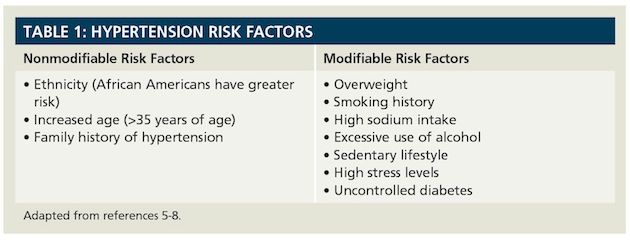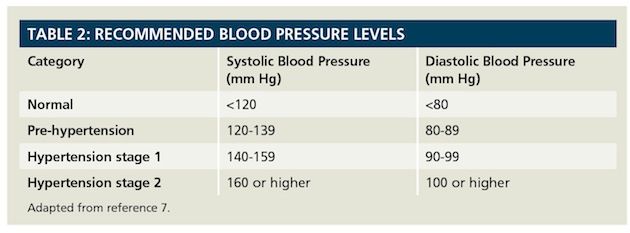Publication
Article
Pharmacy Times
Blood Pressure Monitors: Essential Tool for Hypertension Patients
Author(s):
Help patients choose the right monitor for their needs.
Help patients choose the right monitor for their needs.
An estimated 74.5 million Americans, or 1 of 3 individuals 20 years and older, currently have hypertension.2-4 Among those who have hypertension, only 79.6% are aware that they have it, an estimated 70% are currently being treated, and only 47.8% have their blood pressure under control.1,2 In addition, approximately 25% of American adults are classified as prehypertensive.2-5
Results from a study published in Circulation indicate that those who maintain or decrease their blood pressure during middle age have a reduced lifetime risk of cardiovascular disease.6 Risk factors for hypertension are presented in Table 1.5-8
Hypertension is striking earlier and earlier; according to results from a recent study conducted by the National Institutes of Health, 19% of young adults (aged 24 to 32 years) have the condition and many are unaware of their status.3 Table 27 outlines blood pressure levels and their corresponding classifications.
Fortunately, hypertension can be effectively controlled. Key to success in treating the condition are early intervention, adhering to dietary guidelines and pharmacologic therapy as needed, and routinely monitoring blood pressure. It is essential, therefore, for patients to have a reliable blood pressure monitor on hand.


Target Patient Populations
Pharmacists should be prepared to assist patients in selecting a blood pressure monitor that best suits their individual needs and ensure that patients are properly educated on how to use their monitor properly.
The American Heart Association recommends at-home blood pressure monitoring for all patients with hypertension, but at-home monitoring is considered to be especially beneficial for the following patient populations6,7:
- Patients initiating therapy with antihypertensive agents (to determine effectiveness of therapy)
- Patients requiring closer monitoring other than intermittent physician office visits (ie, patients with coronary heart disease, diabetes, or renal disease)
- Patients who have had elevated blood pressure readings at the doctor’s office, to rule out “white coat syndrome” and confirm true hypertension
- Pregnant women, because preeclampsia can develop rapidly
- Elderly patients, because the white coat effect increases with age
- Patients suspected of having masked hypertension
- Patients with risk factors associated with hypertension
Blood Pressure Monitor Types
There are 3 types of blood pressure monitors: mercury column, aneroid, and digital.6,7 Aneroid and digital monitors are the types most commonly used for at-home blood pressure monitoring.2,6,7 Among the factors typically considered in selecting a monitor are cost, cuff size, ease of use, patient preference, memory features, digital display size, reliability, and accuracy.3,5,7 Some monitors have cuffs that are self-inflating and -deflating, and many have features such as the ability to store several readings, large display screens for increased readability, the ability to print out readings, irregular heartbeat detectors, and pressure rating detection.
Digital monitors are the most popular monitors due to their ease of use. They are available for the upper arm or the wrist. Patients selecting an arm monitor should be advised to purchase a monitor with a cuff size that will accommodate the circumference of their upper arm to ensure accurate results.6,7
Wrist monitors are compact and portable, but some studies suggest that they are not as accurate as upper arm monitors and that erroneous results may be produced due to differences in the positioning of the wrist relative to the heart when measuring.4,7 The American Heart Association recommends that patients use an automatic cuff-style upper arm monitor rather than a wrist monitor because the brachial artery in the upper arm gives a more reliable reading than the wrist artery.5,7-9
Aneroid monitors are light, portable, and generally very affordable. It is imperative that patients be instructed on how to use these monitors to ensure accurate results.4 Many aneroid monitors come with a stethoscope attached to the cuff, which frees the patient from having to hold the stethoscope bell in place.6,7 A few monitors also have the gauge attached to the inflation bulb, allowing for easier handling.7 The accuracy of readings with standard aneroid monitors is dependent upon various factors, such as good eyesight, hearing, and manual dexterity.7 Patients with decreased vision may opt for an aneroid meter with large print on the face of the gauge for easier reading.7
Patients who use aneroid meters should be informed that when the cuff is completely deflated and lying on the table, the needle of the gauge should rest in the box. If the needle lies outside the box, the gauge will need to be recalibrated, and the patient should contact the manufacturer of the device for instructions on recalibration or contact their primary health care provider.6,7
Encourage Healthy Practices
During counseling, pharmacists should emphasize the importance of regularly monitoring blood pressure to ensure that therapy is working or to determine if therapy changes need to be made. Patients should also be reminded of the serious consequences associated with uncontrolled blood pressure and the importance of adhering to their treatment protocol, which may include weight loss, reduced salt intake, smoking cessation, and regular exercise.
Patients should be encouraged to see their primary health care provider for routine checkups and to immediately seek medical attention if their blood pressure readings are elevated or if they experience blurred vision, headaches, or dizziness.
Table 3: Blood Pressure Self-Monitoring Tips
Patient should be advised to empty bladder before testing to avoid inaccurate readings.
Before taking a reading, make sure that the room temperature is comfortable. Relax in a chair next to a table for at least 3 to 5 minutes, sitting straight with your back against the chair, legs uncrossed, and feet flat on floor. Rest forearm on the table with the palm of your hand facing up.
Do not smoke within 30 minutes or drink caffeinated beverages within 60 minutes of taking blood pressure.
Do not talk or eat while taking a reading. Always wait at least 10 to 15 minutes after bathing or showering before measuring blood pressure.
When possible, roll up the sleeve on your arm or remove any tight-sleeved clothing before applying cuff.
If using an arm cuff, the arm should rest comfortably on a table to ensure that it is at heart level. Make sure that the cuff is fitted properly on the arm; it should be snug, but not tight enough to restrict blood flow.
If using a wrist cuff, the wrist should rest on pillows so that it is raised to heart level.
If uncertain about results, take 2 readings at least 2 minutes apart to ensure accuracy.
Routinely check batteries on electronic monitors and store monitor according to instructions.
Compare your results and discuss any concerns or inconsistencies with your primary health care provider. Check blood pressure monitor at least once per year to ensure accuracy.
Patients taking prescription medications for hypertension should measure blood pressure at the same time each day or as often as recommended to ascertain the effectiveness of antihypertensive therapy.
Adapted from references 4-9.
Ms. Terrie is a clinical pharmacy writer based in Haymarket, Virginia.
References
- Hypertension. National Institutes of Health website. http://report.nih.gov/nihfactsheets/ViewFactSheet.aspx?csid=97. Accessed October 28, 2012.
- 2012 High Blood Pressure Statistics. American Heart Association website. www.heart.org/idc/groups/heart-public/@wcm/@sop/@smd/documents/downloadable/ucm_319587.pdf. Accessed October 28, 2012.
- More young adults at risk for high blood pressure. NIH Medline Plus website. www.nlm.nih.gov/medlineplus/magazine/issues/fall11/articles/fall11pg10-11.html. Accessed October 28, 2012.
- High blood pressure facts. Centers for Disease Control website. www.cdc.gov/bloodpressure/facts.htm. Accessed October 25, 2012.
- Why blood pressure matters. American Heart Association website. www.heart.org/HEARTORG/Conditions/HighBloodPressure/WhyBloodPressureMatters/Why-Blood-Pressure-Matters_UCM_002051_Article.jsp. Accessed October 25, 2012.
- Middle-age blood pressure changes affect lifetime heart disease, stroke risk. American Heart Association website. http://newsroom.heart.org/pr/aha/middle-age-blood-pressure-changes-220798.aspx. Accessed October 25, 2012.
- Briggs G, Hurley H. Home testing and monitoring devices. In Krinsky D, Berardi R, Ferreri S, et al, eds. Handbook of Nonprescription Drugs. 17th ed. Washington, DC: American Pharmacists Association; 2012.
- Understanding blood pressure readings. American Heart Association website. www.heart.org/HEARTORG/Conditions/HighBloodPressure/AboutHighBloodPressure/Understanding-Blood-Pressure-Readings_UCM_301764_Article.jsp. Accessed October 25, 2012.
- Choosing a blood pressure monitor. American Heart Association website. www.heart.org/HEARTORG/Conditions/HighBloodPressure/SymptomsDiagnosisMonitoringofHighBloodPressure/Choosing-a-Home-Blood-Pressure-Monitor_UCM_303322_Article.jsp. Accessed October 25, 2012.







